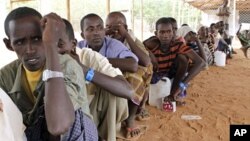With resources at Kenya’s overcrowded Dadaab refugee camps stretched thin, longtime residents of the camps have extended a helping hand to new arrivals.
Helping each other
Upon arrival at the registration center in the Dagahaley refugee camp in Dadaab, Kenya, families fleeing the famine in Somalia are greeted by perhaps a surprising sight. Before receiving even their first rations from the World Food Program, new arrivals to the camps are handed a pack of supplies by their fellow refugees.
With people pouring in to Dadaab in recent months, long-term residents of the Dagahaley, Hagadera and Ifo refugee camps have joined with the United Nations Refugee Agency, or UNHCR, and other organizations to not only support those fleeing the crisis, but also to welcome them to their new homes.
Most immediate needs met
In the registration lines, established residents of the Dagahaley camp distribute new shoes, which are often badly needed by those who have arrived after weeks on foot. The arriving refugees also receive new clothes and milk for young children in immediate need of nutrition.
In the Dagahaley registration center, community leader Bashir Ahmed Bir passes out shoes to new arrivals.
Bir says many of the items being supplied to the refugees are being supplied in the Dagahaley market, through the support of the Muslim community in Dadaab and other cities throughout Kenya. Community efforts have recently been aimed at the new arrivals, and settled residents of the camps have been encouraged to contribute for the new arrivals.
In recent months, tens of thousands of Somalis have risked the long journey to Dadaab in search of a respite from the ongoing famine in Somalia. But for numerous camp residents, Dadaab is home. Around 400,000 now live in the three camps surrounding Dadaab. Many have been there since the early 1990's, when the last Somali famine sent people streaming across the border. Since then, the camps have evolved from temporary centers of crisis response into true communities, complete with shops, schools, religious centers and outreach programs.
They have even organized, choosing representatives to lead the camps and communicate on their behalf to the aid agencies working in the area.
The recent influx of refugees has inundated the already overcrowded camps, creating tensions among those who have been settled for years. But according to recently-elected Dagahaley Community Leader Zeinab Mohamed, community assistance is about more than making room for the new refugees.
All residents of the camps in Dadaab were at one point forced to flee their homes in Somalia and Mohamed said the old residents of Dagahaley feel the pain of the recent arrivals. Mohamed said the old and new arrivals are all Somali and that the Dagahaley community was ready to help.
Burial assistance needed
But community organizations around Dadaab do more than simply welcome refugees; they also provide assistance with more solemn tasks, such as burial of the dead.
Abdullahi Hussein is the leader of the Dadaab Youth Committee.
“These families that are losing their loved ones are very poor families. They cannot even dig the grave; they cannot even buy the clothes used to wrap the dead bodies. We told them that there are such kind of people who are ready to assist you,” Hussein said.
Hussein told VOA that the Dagahaley community often provides families who have lost loved ones - both in the camps and along the journey - with tools to dig the graves as well as proper burial clothes for the deceased.
The groups in Dagahaley have also taken on a coordinating role, designating cemeteries in the camp outskirts for new arrivals, to prevent crowding or random burials. Three burial sites have been opened in the outskirts of both the Dagahaley and Ifo camps, while one has been established in nearby Hagadera.
The community groups also play a role in counting the numbers who have died in the camps. With many of the recent arrivals not yet registered with UNHCR, these figures often elude aid organizations working in Dadaab.
In the 10 days before VOA spoke with Hussein, the youth leader said at least 27 had died in the Dagahaley camp alone, 25 of whom were children. Hussein says around 85 percent of the deaths observed by his organization are children under the age of 5 years old.
The United Nations says only half of the $2 billion needed to address the ongoing famine in East Africa has been contributed by the international community to date. Humanitarian agencies have been strained to the limit trying to cope with the influx in Dadaab, but the local community of refugees appears ready and willing to shoulder at least some of the burden.











